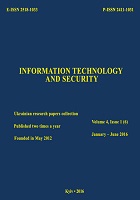Complex analytical models for evaluating the efficiency of transport networks IP / MPLS
DOI:
https://doi.org/10.20535/2411-1031.2017.5.1.120585Keywords:
MPLS, routing protocols, signaling protocol, emulation of network active elements, forwarding table, bit models.Abstract
In this paper conducted evaluating of the effectiveness of networking IP / MPLS, used as a base when deploying modern transport networks. The main requirements that apply to the technology backbone components are: high capacity, a slight delay value message and its scalability. The introduction of modern network technologies such as MPLS requires a sufficiently large logistical cost for its deployment and a prior assessment of the magnitude of the effect, depending on the area of its application. IP-networks only usage does not allow: to provide a flexible, rational distribution of information flows; performance of standardized values of service quality parameters for multimedia traffic; implement a fast and adaptive change of information transmission routes in the event of overloads in the network. In order to substantiate the choice of the proposed technology, the task of creating adequate models that allow quantifying the value of the gain over time in the processing of messages, depending on the size of the network and taking into account the peculiarities of the work of active network equipment with MPLS-switching and IP-routing.
To evaluate the quality of message service in packet networks, the simulation model, boolean algebra and bit models were used. As a result, an analysis of the order and speed of packet service on the IP/MPLS networks was performed based on the simulation model of the corporate network segment. Also integrated analytical models were developed which take into account the peculiarities of network protocols and the operation of the active network equipment. The resulting integrated analytical models can be used to evaluate the effectiveness of IP/MPLS technologies depending on the dimension and network topology.
References
S. Ali, and A.V. Simonenko, Flow model of dynamic queue balancing in MPLS network with support for traffic engineering queues, Telecommunications problems, iss. 1, pp. 59 - 67, 2010.
L. Barash, Virtual private networks based on MPLS, Computer Review, iss. 17, pp. 14 - 16, 2004.
A.B. Goldstein, and B.S. Goldstein, Technology and MPLS protocols. St. Petersburg: St. Petersburg. :BHV, 2005.
V. Olwain, Structure and implementation of modern MPLS technology. Cisco management. Moscow: Williams Publishing House, 2004.
E. Rosen, A. Viswanathan, R. Callon, Multiprotocol Label Switching Architecture, RFC 3031, 2001. [Online]. Available: https://tools.ietf.org/html/rfc3031. Accessed on: May 20, 2017.
V. Olifer, N. N. Olifer The art of traffic optimization, LAN Network Solutions Magazine, iss. 12, p.p. 21 - 26, 2001.
T. Thomas, Structure and implementation of networks based on the OSPF protocol. Cisco management. Moscow: Williams Publishing House, 2004.
Cisco Systems: Documentation [Online]. Available: http://www.cisco.com/cisco/web/psa/ default.html?mode=tech&level0=268435750. Accessed on: May 23, 2017.
A. Akho, J. Hopcroft, and .J. Ullman, Construction and analysis of computational algorithms, Yu.V. Matiyasevich, Ed. Moscow: The World, 1979.
N.V. Budyldina, D.S. Tribunsky, and V.P. Shuvalov, Optimization of networks with multiprotocol commutation by labels. Moscow: Hotline - Telecom, 2010.
D. Woods, MPLS: A New Traffic Controller on Network Highways, Networks and Communication Systems, iss. 12, pр. 10 -18, 2000.
Downloads
Published
How to Cite
Issue
Section
License
Copyright (c) 2020 Collection "Information technology and security"

This work is licensed under a Creative Commons Attribution 4.0 International License.
The authors that are published in this collection, agree to the following terms:
- The authors reserve the right to authorship of their work and pass the collection right of first publication this work is licensed under the Creative Commons Attribution License, which allows others to freely distribute the published work with the obligatory reference to the authors of the original work and the first publication of the work in this collection.
- The authors have the right to conclude an agreement on exclusive distribution of the work in the form in which it was published this anthology (for example, to place the work in a digital repository institution or to publish in the structure of the monograph), provided that references to the first publication of the work in this collection.
- Policy of the journal allows and encourages the placement of authors on the Internet (for example, in storage facilities or on personal web sites) the manuscript of the work, prior to the submission of the manuscript to the editor, and during its editorial processing, as it contributes to productive scientific discussion and positive effect on the efficiency and dynamics of citations of published work (see The Effect of Open Access).

